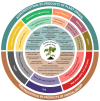Agroindustrial By-Products as a Source of Biostimulants Enhancing Responses to Abiotic Stress of Horticultural Crops
- PMID: 38542496
- PMCID: PMC10970935
- DOI: 10.3390/ijms25063525
Agroindustrial By-Products as a Source of Biostimulants Enhancing Responses to Abiotic Stress of Horticultural Crops
Abstract
Together with other abiotic stresses such as drought and high temperatures, salt stress is one of the most deleterious environmental factors affecting plant development and productivity, causing significant crop yield reductions. The progressive secondary salinisation of irrigated farmland is a problem as old as agriculture but is aggravated and accelerated in the current climate change scenario. Plant biostimulants, developed commercially during the last decade, are now recognised as innovative, sustainable agronomic tools for improving crop growth, yield, plant health and tolerance to abiotic stress factors such as water and soil salinity. Biostimulants are a disparate collection of biological extracts, natural and synthetic organic compounds or mixtures of compounds, inorganic molecules and microorganisms, defined by the positive effects of their application to crops. The growing interest in biostimulants is reflected in the increasing number of scientific reports published on this topic in recent years. However, the processes triggered by the biostimulants and, therefore, their mechanisms of action remain elusive and represent an exciting research field. In this review, we will mainly focus on one specific group of biostimulants, protein hydrolysates, generally produced from agricultural wastes and agroindustrial by-products-contributing, therefore, to more sustainable use of resources and circular economy-and primarily on the consequences of their application on the abiotic stress resistance of horticultural crops. We will summarise data in the scientific literature describing the biostimulants' effects on basic, conserved mechanisms activated in response to elevated salinity and other abiotic stress conditions, such as the control of ion transport and ion homeostasis, the accumulation of osmolytes for osmotic adjustment, or the activation of enzymatic and non-enzymatic antioxidant systems to counteract the induced secondary oxidative stress. The collected information confirms the positive effects of biostimulants on crop tolerance to abiotic stress by enhancing morphological, physiological and biochemical responses, but also highlights that more work is needed to further establish the molecular mechanisms underlying biostimulants' effects.
Keywords: antioxidant systems; circular economy; ionic stress; molecular mechanisms; osmotic stress; oxidative stress; salt tolerance; stress markers.
Conflict of interest statement
The authors declare no conflicts of interest.
Figures




Similar articles
-
Plant Biostimulants to Enhance Abiotic Stress Resilience in Crops.Int J Mol Sci. 2025 Jan 28;26(3):1129. doi: 10.3390/ijms26031129. Int J Mol Sci. 2025. PMID: 39940896 Free PMC article. Review.
-
Enhancement of Plant Productivity in the Post-Genomics Era.Curr Genomics. 2016 Aug;17(4):295-6. doi: 10.2174/138920291704160607182507. Curr Genomics. 2016. PMID: 27499678 Free PMC article.
-
Biostimulants for the Regulation of Reactive Oxygen Species Metabolism in Plants under Abiotic Stress.Cells. 2021 Sep 25;10(10):2537. doi: 10.3390/cells10102537. Cells. 2021. PMID: 34685517 Free PMC article. Review.
-
Plant growth-promoting microbes and microalgae-based biostimulants: sustainable strategy for agriculture and abiotic stress resilience.Philos Trans R Soc Lond B Biol Sci. 2025 May 29;380(1927):20240251. doi: 10.1098/rstb.2024.0251. Epub 2025 May 29. Philos Trans R Soc Lond B Biol Sci. 2025. PMID: 40439314 Free PMC article. Review.
-
The power of seaweeds as plant biostimulants to boost crop production under abiotic stress.Plant Cell Environ. 2022 Sep;45(9):2537-2553. doi: 10.1111/pce.14391. Epub 2022 Jul 19. Plant Cell Environ. 2022. PMID: 35815342 Review.
References
-
- El-Ramady H., Prokisch J., Mansour H., Bayoumi Y.A., Shalaby T.A., Veres S., Brevik E.C. Review of crop response to soil salinity stress: Possible approaches from leaching to nano-management. Soil Syst. 2024;8:11. doi: 10.3390/soilsystems8010011. - DOI
Publication types
MeSH terms
Substances
LinkOut - more resources
Full Text Sources

